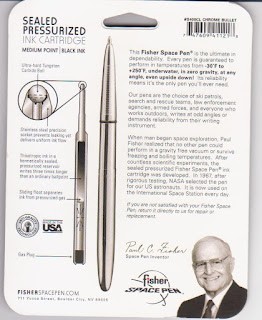NASA Spent Millions to Develop a Pen that Would Write in Space, whereas the Soviet Cosmonauts Used a Pencil.
An AG-7 Astronaut Space Pen in presentation case.
1960s, legend has it, NASA scientists realized that pens could not function in space. They needed to figure out another way for the astronauts to write things down. So they spent years and millions of taxpayer dollars to develop a pen that could put ink to paper without gravity. But their crafty Soviet counterparts, so the story goes, simply handed their cosmonauts pencils.
Originally, NASA astronauts, like the Soviet cosmonauts, used pencils, according to NASA historians. In fact, NASA ordered 34 mechanical pencils from Houston's Tycam Engineering Manufacturing, Inc., in 1965. They paid $4,382.50 or $128.89 per pencil. When these prices became public, there was an outcry and NASA scrambled to find something cheaper for the astronauts to use.
Pencils may not have been the best choice anyway. The tips flaked and broke off, drifting in microgravity where they could potentially harm an astronaut or equipment. And pencils are flammable--a quality NASA wanted to avoid in onboard objects after the Apollo 1 fire.
Paul C. Fisher and his company, the Fisher Pen Company, reportedly invested $1 million to create what is now commonly known as the space pen.
In 1965 Fisher patented a pen that could write upside-down, in frigid or roasting conditions (down to minus 50 degrees Fahrenheit or up to 400 degrees F), and even underwater or in other liquids. If too hot, though, the ink turned green instead of its normal blue.
That same year, Fisher offered the AG-7 "Anti-Gravity" Space Pen to NASA. Because of the earlier mechanical pencil fiasco, NASA was hesitant. But, after testing the space pen intensively, the agency decided to use it on spaceflights beginning in 1967.
Unlike most ballpoint pens, Fisher's pen does not rely on gravity to get the ink flowing. The cartridge is instead pressurized with nitrogen at 35 pounds per square inch. This pressure pushes the ink toward the tungsten carbide ball at the pen's tip.
The ink, too, differs from that of other pens. Fisher used ink that stays a gellike solid until the movement of the ballpoint turns it into a fluid. The pressurized nitrogen also prevents air from mixing with the ink so it cannot evaporate or oxidize.
How space pen was made?
The ballpoint is made from tungsten carbide and is precisely fitted in order to avoid leaks. A sliding float separates the ink from the pressurized gas. The thixotropic ink in the hermetically sealed and pressurized reservoir is able to write for three times longer than a standard ballpoint pen. The pen can write at altitudes up to 12,500 feet (3800 m).
The ink is forced out by compressed nitrogen at a pressure of nearly 35 psi (240 kPa). Operating temperatures range from −30 to 250 °F (−35 to 120 °C). The pen has an estimated shelf life of 100 years.
And
Wikipedia




No comments:
Post a Comment